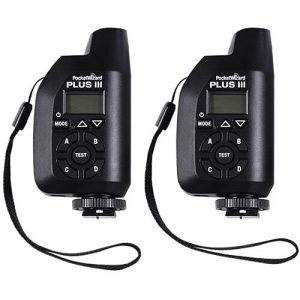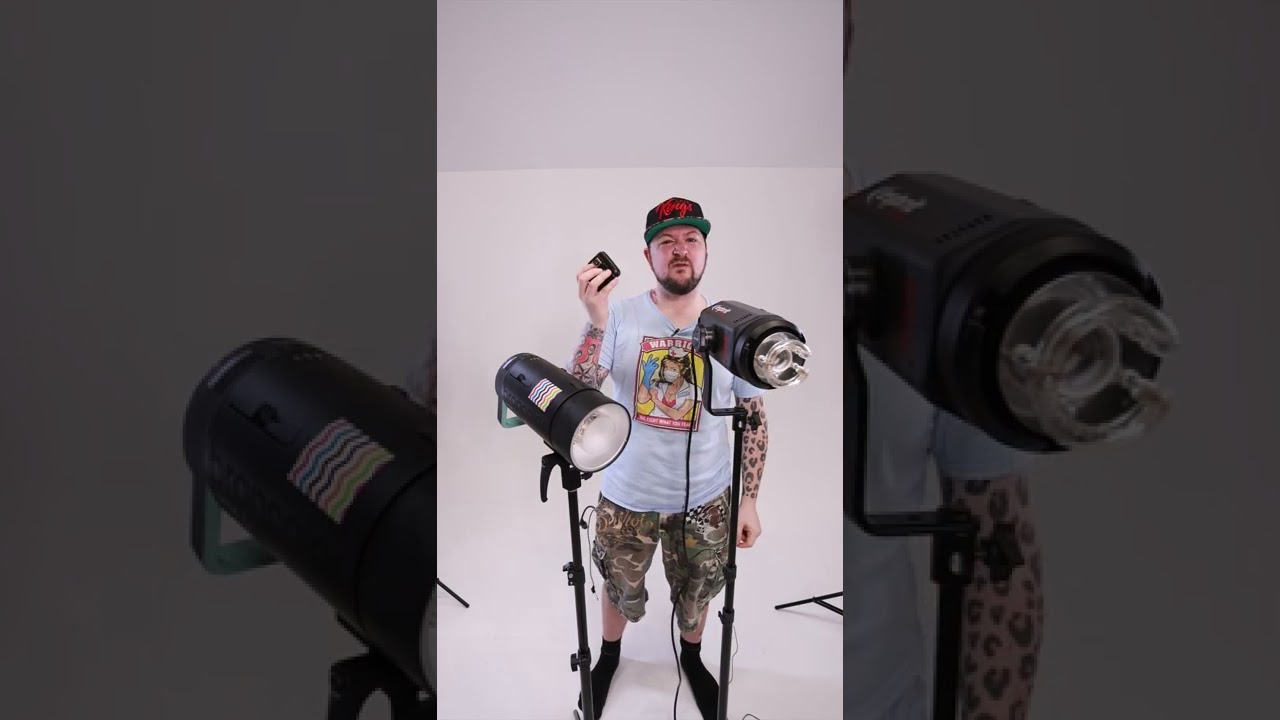What are strobe light triggers, and why do you need to be in complete control of your lights!?
Episode 7 of 1 minute 101's v2
Firing strobe lights using a trigger and receivers
There are a few ways to fire a strobe light and make it talk to your camera. You can use a wireless trigger and receiver / transceiver, you can physically wire it up to a light from your camera using a sync cable, or you can fire them by using their optical receiver. We're going to talk about optical receivers in the next video more as these are really best used for triggering multiple lights off of a master flash (so see the next blog for jargon explanations), however, you'll never know when you may need the optical option as a get out of jail free card too!?

^ The most basic trigger and receiver set up ^
So imagine the scene.. you can't find a lead or a trigger, or they're broken, or the trigger has run out of battery or something, after all, it's really easy to not have a spare 12v battery and/or a tiny screwdriver to change it with. To be honest, it's just easy to forget or misplace something small like the trigger itself, and certainly a sync cable in the modern day, but never fear, you didn't however forget your trusty speedlite! You've brought said Speedlite (the small flashguns that you shove on top of your camera) as a 'just in case' option, or because it was chunky enough that it's harder to forget, and/or you always have it in your gig bag, and well, the good news is, many studio strobes can fire from their optical receiver just by using the flash from your built-in/on camera. I've relied on it before, and I've seen many others do so too, not least because sometimes your key (main) light and any the others in the set up may be so tightly controlled from spilling amongst one another that they don't fire optically off one another, and then this becomes an (less than) ideal hack assuming you don't have a receiver for each light individually.
If you can, power your on-camera-flash right down, or even twist the speedlite to face the ceiling or wall so it's not an influence on your subject (not all speedlites twist and tilt), and now you can use your speedlite's tiny pulse of light to fire all the studio lights without the use of any trigger or a sync cables. As for said sync cable, it does exactly as it suggests.. well not quite, you still have to aid it with a few basic setting adjustments. Prosumer studio strobes, which are the majority that aren't too fancy and don't have high speed sync as mentioned in the Broncolor blog; well they typically can't use a higher shutter speed than 200, some 160 possibly, but maybe even 125 to be on the safe side! In fact, I was speaking to another photographer the day I wrote this who suggested he had to drop down to 60! It can depend on the camera or the strobes.. a few things really, but the fact is, you need to take shutter speed in to account regardless.
A photography strobe's pulse of light is so fast that it'll freeze basic movement, so unless you're using a shutter speed that is far too slow (which can be done creatively) and there is loads of ambient light that you're mixing in with the flash, then you shouldn't need more than 125, possibly even 60! If that isn't working, and you're getting blur with strobes, then the chances are that you are underexposing your subject and not hitting them with enough clean light. At the other end, however, this will manifest by getting (a) black line(s) in your image; it may even look like vignetting and not be immediately obvious. That is your camera's shutter curtain obscuring some of the frame, and as suggested, it happens when your sync speed is too high and usually above 160/200/250+ thresholds. This catches everyone out when they first start shooting, and not least if they have experience with speedlites as they're typically faster and can often allow you to shoot up to 250th of a second. Of course, and as proved by said friend about coming down to 60, there are exceptions to every rule, but keeping your shutter between 125 and 160 with very little ambient light, will serve you just fine in the studio.

Pocket wizards used to be the expensive daddy and THE answer to transceivers back in my day
Having said that, however, in this day and age people are getting used to fancier lighting that is forever getting cheaper and more assessable as the photography light tech industry quickly progresses. When they are paired with a compatible trigger, these strobes may also talk to the camera like your speedlites do, so if you know no different, this can give you a false confidence that this is how all studio strobes work, and it can kinda fast track you on to an easy road to complacency and a lack of understanding. What I have noticed at the studio these last couple of years too, is that of the world of influencers. They know a little, but in the words of Paul Daniels, "not a lot", and they can skirt by and think they're a master photographer by letting their camera take images while they do the whole angles and direction thing. Having little idea of how a camera and proper lighting actually works isn't a formula for arrogance, and combine that with them being unable to mentally picture a light that they can't physically see; it can be a rude awakening that those who have ambition will take on the chin and then progress their skill level. Even with a model light on, pretty much every strobe light is a light you can't see the effects of. Model lights will show the direction of the light and where they're hitting the subject, but they're so soft that they can't possibly predict the reality of what the photo will look like past those minor conveniences, which is pretty much why I rarely use them.
Now, whether that content and direction of knowing what people want in the modern day for socials is replacing our dinosaur photographer minds of focusing our egos in to striving for technical execution to be amired amoungst our peers, well, that is a debate for a different day! What is for sure, is that they're never going to be in control and thus will be taking inconsistent photos with their lack of understanding, and they would crumble in a real life editorial scenario if they don't choose to power through the knowledge barrier and learn to earn it - kinda like how Brooklyn Beckham got laughed out of photography and became a chef. It's a big, scary world out there with a little knowledge, hell, it's a big scary world out there with a lot of knowledge, and if you end up facing something new (which we all do! Power phrasing, I think David Bailey once said something along the lines of "You would have thought I knew what I was doing by now") that you're not sure that you've got a 100% of a handle on, it will kill off those with zero ambition in double quick time - or they'll get lucky and be a maverick!
Naivety is brilliant to have when the world is against you, as it is for anyone new to any industry/hobby who needs the drive to keep moving forward by thinking they're something special. It keeps you going and shapes your style while not giving in to trends and expectations, but I can also assure you, you will still need to be fully in control of your lights and camera to maximise consistency. To do this, you need to be setting everything up (white balance is arguably forgivable if shooting in RAW) in manual. The point I was getting to here and why I went off on a philosphical tanget, was, that many new studio strobes in this day and age have built in receivers, but this is, A), typically a brand specific thing, and B), very much still a part of the future and not even close to being universal, so in reality, it's not a big deal other than over complicating the process of using other people's strobe lights that aren't the same as yours. If you want to gain credibility and move on to bigger and better jobs, it's best to know what you're doing, and/or to have a gift and an unrivalled confidence (Naivety/Arrogance) to be able to bullshit your way out and in to a plan b or c, and all while still delivering for the client.
In conclusion to the above waffle, the point of studio photography is that you're fully in control, and despite scaremongering, we're still a million miles away from Ai being able to create pictures of hands with an internet's worth of material to draw from, never mind a dumb computer chip in a camera/light trying to understand a creative scenario and then taking every photo with the perfect light and correct exposure. Hell, it'll shift your white balance from shot to shot in the same set as you change angle as it sees slightly different 'greys' each time, never mind it knowing what your brain is thinking and what your trying to achieve. Technological advances in photography make the tools easier to use, it helps them push past their previous limits by making sync speeds more expansive, or by giving you way more wiggle room between your highlights and shadows (dynamic range) - stuff like this - what it can't do is not be a tool and replace the human brain and understanding!

My Broncolors use a similar trigger to this where the receivers are built in to the lights themselves.
The obvious disadvantage of using a cable straight to your light is of course being teathered and having less freedom, and while these cables can be long, they often break easy too, or they fall out of your camera's sync port if you breathe on them just a little too heavy, so this is why triggers and receivers are the way to go. They're not a bad idea to have lying around just in case as they take up such little room and weight, but equally, I could see many future cameras moving away from the ports used for these cables, so it wouldn't surprise me if the old skool PC port cables are dumped in the near future.
To use a wireless trigger, you will also need a hotshoe on your camera. The hotshoe is the little ledge of electronic magic where you attach your speedlite, and in this case, it is where the trigger will go. 'Hot' basically means it's got flat metal connector plates that are ready to pair up with whatever you stick on there, and there needs to be a centre one to fire the most basic of triggers. Not every camera has a hotshoe however, and some have cold shoes, or ones with less connectivity (no centre pin), so hotshoes are typically reserved for the better hobbyist, prosumer and professional camera models. If you're not familiar with most of what I've just said, I urge you to do research your camera prior, because if you don't have a camera body with a hotshoe or a sync port, your ability to use strobes lighting is probably going to be null and void and limit what you can do in the studio
